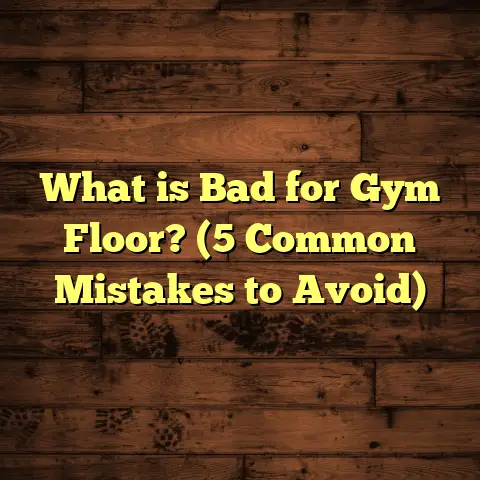What is AC4 Flooring? (5 Benefits for Your Home’s Durability)
It’s funny how sometimes the toughest materials come in the most unexpected packages. You might think something that looks like simple laminate can’t possibly handle heavy use or last long, right? Well, that’s where AC4 flooring pops in and surprises you. I’ve spent years working with all kinds of flooring materials—from hardwood to vinyl to carpet—and AC4 laminate has proven itself over and over as a reliable choice for durability and style. But what exactly is AC4 flooring? And why should you consider it for your home?
What Is AC4 Flooring?
The term “AC” stands for Abrasion Class, which is a rating system used for laminate flooring to measure its durability and resistance to wear. The number following it, in this case 4, indicates the level of durability the floor has under normal household or moderate commercial use.
Abrasion class ratings are part of a European standard (EN 13329) for laminate floors. This standard measures how well the top layer of the laminate withstands surface wear caused by foot traffic, furniture movement, pets’ nails, and other everyday challenges. The test involves rubbing the surface with an abrasive material thousands of times to simulate long-term wear.
AC4 means the flooring can withstand approximately 2,000 cycles of this abrasion test before noticeable damage appears. This level is suitable not just for homes but also for moderate commercial environments such as small offices or boutiques.
How Is AC4 Different from Other Laminate Floors?
Abrasion classes range from AC1 to AC5:
- AC1: Light residential use—bedrooms or closets where foot traffic is minimal.
- AC2: Moderate residential use—living rooms or dining rooms without heavy daily foot traffic.
- AC3: Heavy residential use—kitchens, hallways, entryways where wear is more frequent.
- AC4: General commercial use—offices, small shops, or busy residential spaces with pets and kids.
- AC5: Heavy commercial use—public buildings, department stores, airports with very high traffic.
Now, imagine this: if AC1 laminate could be considered the “casual runner” of flooring options, AC4 is like a seasoned marathoner. It’s built to endure the daily grind without breaking a sweat.
I remember one project where a client had three young kids and two dogs running around constantly. They wanted floors that could handle all the chaos without looking worn out after just a year or two. AC4 laminate was my recommendation, and after four years, their floor still looks fantastic with only minor signs of wear.
5 Benefits of AC4 Flooring for Your Home’s Durability
Let me walk you through five reasons why I often suggest AC4 flooring when durability is a priority.
1. Superior Resistance to Scratches and Wear
If you have kids or pets like I do, you know how quickly floors can get scratched or scuffed. Kids dragging toys across the floor or pets running with sharp nails can leave marks on surfaces that aren’t tough enough.
AC4 flooring has a wear layer that’s designed specifically to resist this kind of damage. The wear layer is typically made from melamine resin and aluminum oxide particles, which together create a hard surface that protects against scratches and dents.
In lab tests, AC4 laminate withstands roughly 2,000 abrasion cycles compared to just 600 cycles for AC2 laminate. In real life, this translates to years of daily wear without visible damage.
Think about it this way: I once installed AC2 laminate in a rental property that saw moderate foot traffic but didn’t last more than 3 years before visible scratches appeared. In contrast, my own home’s AC4 laminate has held up well for over 6 years despite having energetic teenagers and a large dog.
2. Cost-Effective Durability
You might wonder if paying more for AC4 compared to AC3 or AC2 is justified. From what I’ve seen over multiple projects, it definitely pays off.
While hardwood floors can cost anywhere from $8 to $15 per square foot installed (sometimes even more depending on species), AC4 laminate typically runs between $2.50 and $5 per square foot including installation. That’s a huge difference.
Moreover, the lifespan of AC4 laminate in residential settings often matches or exceeds less durable hardwoods that may scratch easily or require refinishing every few years.
A client of mine switched from thinking hardwood was the only option to choosing AC4 laminate after I showed them cost comparisons including maintenance over 10 years. The numbers convinced them—especially since they have young kids who are tough on floors.
3. Easy Cleaning and Maintenance
Floors don’t just need to be tough; they need to be easy to care for.
AC4 laminates are simple to maintain. Unlike hardwood floors that need special cleaners and occasional refinishing, these laminates require just regular sweeping or vacuuming and an occasional damp mop with a mild cleaner.
I always recommend avoiding harsh chemicals or soaking the floor with water. Quick spill cleanup prevents moisture damage and keeps floors looking new longer.
This low maintenance means no expensive upkeep bills or time-consuming chores—something I appreciate personally since my schedule doesn’t allow much spare time for home cleaning projects.
4. Better Moisture Resistance Than Lower Grades
Laminate flooring isn’t completely waterproof—that much is true. But AC4 laminates often have improved moisture resistance compared to lower-grade laminates due to better core materials and improved surface coatings.
The core boards in AC4 laminates are usually high-density fiberboard with moisture-resistant treatments. Plus, the surface layers have tighter seals around edges thanks to advanced locking systems.
In one home I worked on in a humid climate near the coast, the client experienced accidental water spills in the kitchen over several years without any warping or swelling in their AC4 laminate floor.
That’s not something you’d expect from lower-grade laminates or cheaper engineered wood products.
5. Wide Range of Stylish Options
When clients think durable floors mean sacrificing beauty, I like to show them samples of AC4 laminates.
They come in tons of designs that mimic wood grains—from rustic oak to walnut—and even stone or tile textures with realistic finishes. The textures aren’t just visual; some laminates have embossed surfaces that feel like real wood underfoot.
The beauty of AC4 is that you don’t have to compromise style for durability. You get both.
How I Use FloorTally to Manage Costs and Project Planning
Estimating costs accurately is critical in any flooring project. Overestimating wastes money; underestimating causes headaches down the road.
I remember early in my career struggling with cost estimates because material prices vary by region; labor rates fluctuate; waste factors differ based on room shape; and sometimes clients change their minds during installation.
That’s why I started using FloorTally—a tool that helps me calculate precise material needs and costs quickly based on real-time local data.
Here’s how it helps:
- I enter room dimensions.
- Choose the type of flooring (like AC4 laminate).
- Select local labor rates.
- Add waste percentage (usually 5-10%, depending on room complexity).
- Get detailed cost breakdowns instantly.
For example, for a 600 sq ft living room with complex alcoves and doorways, FloorTally helped me avoid ordering too little material while keeping costs within budget by accounting for waste accurately.
Having this data upfront allows me to discuss budgets confidently with clients and plan installations without delays caused by material shortages.
Technical Details Behind AC4 Durability
Let’s get a little more technical about what makes AC4 laminate stand out durability-wise:
Wear Layer Thickness
The wear layer thickness varies but generally ranges from 0.3 mm to 0.5 mm on AC4 laminates. This transparent layer is crucial because it absorbs surface scratches and protects the decorative layer beneath it.
Thicker wear layers generally mean longer lifespan since they take longer to wear through under heavy use.
Core Board Density & Composition
The core board is usually made from High-Density Fiberboard (HDF) treated for moisture resistance and structural strength. A denser core reduces chances of dents from dropped objects or heavy furniture.
Some manufacturers also add water-resistant coatings to improve performance in damp areas.
Surface Coatings
Multiple layers of melamine resin combined with aluminum oxide particles form tough protective coatings that resist stains, fading from UV exposure, and impact damage.
These coatings also make cleaning easier since dirt doesn’t penetrate easily.
Locking Systems
Many modern AC4 products feature click-lock systems that snap boards together tightly without glue or nails. This creates stable seams that reduce moisture infiltration and make floating floor installation possible.
Installing AC4 Flooring: Tips from My Experience
Installation quality affects durability just as much as material quality. Here are some practical tips I follow when installing AC4 laminate:
- Acclimate Flooring: Let the planks sit in the room for at least 48 hours before installation so they adjust to temperature and humidity.
- Prepare Subfloor: Ensure subfloor is clean, level, dry, and free from debris to avoid plank damage or uneven wear.
- Use Underlayment: A proper underlayment improves comfort underfoot, reduces noise, and adds moisture barrier protection.
- Leave Expansion Gaps: Leave small gaps around walls (usually 1/4 inch) so the floor can expand/contract without buckling.
- Stagger Seams: Avoid lining up seams parallel across rows; stagger them by at least 12 inches for strength.
- Cut Carefully: Use appropriate tools like laminate cutters or fine-tooth saws for clean cuts without damaging edges.
- Clean After Installation: Remove all dust/dirt immediately to prevent scratches during first use.
Following these steps helps ensure that your durable AC4 floor performs optimally for many years.
Maintenance Advice Based on Real-Life Use
To keep your AC4 flooring looking great:
- Sweep/vacuum frequently using soft brushes to avoid abrasive dirt buildup.
- Mop occasionally with damp microfiber mops; avoid soaking.
- Use felt pads under furniture legs to prevent scratching.
- Clean spills quickly to avoid moisture seepage.
- Avoid harsh chemicals (bleach/acids) which can degrade protective layers.
- Consider area rugs at entrance points to trap dirt.
I’ve seen many floors last decades simply because homeowners took these small but consistent maintenance steps seriously.
Common Problems & How To Solve Them
Even tough floors can face issues if not installed or maintained properly:
- Warping/Swelling: Usually caused by excessive moisture exposure or poor subfloor prep. Solution: Fix leaks immediately; use dehumidifiers; replace damaged planks if necessary.
- Gapping Between Planks: Happens if expansion gaps weren’t left or if humidity swings are extreme. Solution: Reinstall with proper gaps; maintain indoor humidity between 35%-55%.
- Surface Scratches: Can occur from dragging heavy furniture or sharp objects. Solution: Use furniture pads; repair minor scratches with specialized kits.
- Peeling or Delamination: Rare in quality AC4 but can happen if subfloor moisture is excessive or if product was faulty. Solution: Replace affected areas; improve moisture barriers under subfloor.
If you encounter problems early on, consult your manufacturer’s warranty terms—many offer coverage for up to 15 years on wear resistance for AC4 rated products.
Comparing AC4 Flooring with Other Popular Options
To help you decide if AC4 laminate fits your needs best, here’s how it stacks up against some common alternatives:
| Flooring Type | Avg Cost per Sq Ft Installed | Durability (Years) | Maintenance Level | Moisture Resistance | Appearance Variety |
|---|---|---|---|---|---|
| Hardwood | $8 – $15 | 20+ | Medium | Low | High |
| Engineered Wood | $6 – $12 | 15+ | Medium | Medium | High |
| Vinyl Plank | $3 – $7 | 10 – 20 | Low | High | Medium |
| Carpet | $2 – $5 | 5 – 10 | High | Low | Medium |
| Laminate (AC3) | $2 – $4 | 5 – 8 | Low | Low | Medium |
| Laminate (AC4) | $2.50 – $5 | 10 – 15 | Low | Medium | High |
This table reflects industry averages and my personal experience over dozens of installations across different climates and usage scenarios.
Real-Life Stories That Show Why AC4 Matters
One memorable client had a retail shop that saw hundreds of customers daily. They wanted flooring tough enough for commercial use but without the high price tag of tile or vinyl. We installed an AC4 laminate floor that still looked great after three years despite constant foot traffic and heavy displays being moved around regularly.
Another time, a family wanted new floors but had a tight budget and two large dogs. Hardwood was out of reach financially. We went with an oak-look AC4 laminate that matched their style perfectly and handled muddy paws without issue. After four years, their floor still looks showroom fresh—a perfect mix of practicality and style at a reasonable price.
Final Thoughts (Without Saying “In Conclusion”)
Choosing floors is a big decision because they affect your home’s look, feel, maintenance needs, and resale value. From what I’ve learned working hands-on with materials and clients over many years:
- AC4 flooring offers excellent durability suitable for most homes.
- It balances performance and cost better than many alternatives.
- It’s easy enough to maintain even for busy households.
- Modern options give you plenty of style choices.
- Tools like FloorTally make planning cost-effective projects easier than ever.
If you want floors that can take everyday life’s knocks without losing charm—and save some money while you’re at it—AC4 laminate should be high on your list.
Feel free to ask me about specific brands, installation tips, or how this could fit your exact needs—I’m always happy to share what I’ve learned from real projects!





